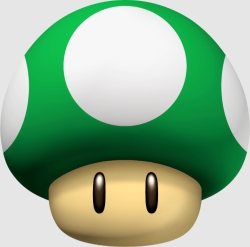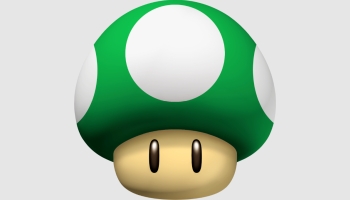 A good introduction can work wonders for getting an audience interested in your game. Just look at all the words written about the importance of World 1-1 in Super Mario Bros. (not to mention all the video essays and podcasts and infographics and interpretive dance performances).
A good introduction can work wonders for getting an audience interested in your game. Just look at all the words written about the importance of World 1-1 in Super Mario Bros. (not to mention all the video essays and podcasts and infographics and interpretive dance performances).
Not every game can feature such a crackerjack introduction, and even if it did, most people will often first experience a game through some encouraging words from a friend or some kind of advertisement. This first impression is no less important, and we’ll look at three of them in this edition of Bite-Sized Game History.
![]() You can find a lot of dedicated video game historians on Twitter, and in 280 characters or less, they always manage to unearth some amazing artifacts. Bite-Sized Game History aims to collect some of the best stuff I find on the social media platform.
You can find a lot of dedicated video game historians on Twitter, and in 280 characters or less, they always manage to unearth some amazing artifacts. Bite-Sized Game History aims to collect some of the best stuff I find on the social media platform.
About halfway through World 1-1 in the aforementioned Super Mario Bros., players will discover a secret Mushroom hidden if they know where to look. While Mario’s fans would alternately refer to this prize as an extra life or a free guy, Super Mario Bros. was one of the first games to refer to this item on screen as a 1-Up.
When you stop to think about it, 1-Up actually makes a lot of sense… collecting a 1-Up Mushroom increments your total number of lives up by one. A handful of games used 1-Up before Super Mario Bros. popularized it, but where exactly did the term come from?
Believe it or not, it originated with pinball tables, and it didn’t have anything to do with incrementing a counter. According to Supper Mario Broth, the phrase 1st Player “Up” was used in 1963 on the backglass art for Midway’s Race-Way. It appeared on other tables over the years and was eventually shortened to the 1-Up we all know and love before making the jump to video games a few decades later:
The name of the 1-Up Mushroom from the Mario series can be traced back to a 1963 pinball machine, which used the phrasing "1st player up" to indicate the player's turn. Over time, this morphed into associating the phrase "1up" with extra lives. Details in image. pic.twitter.com/nYSvKls3xU
— Supper Mario Broth (@MarioBrothBlog) October 5, 2020
1995’s Wipeout was one of the PlayStation’s earliest hits, and it helped usher in the conventional wisdom that Sony’s console was the more adult option over the Saturn or the then-upcoming Nintendo 64. This was especially true after its background introduction in Hackers, a cult film that starred a young Angelina Jolie in one of her first roles. But it made an even bigger splash in the UK, where its blend of futuristic racing and pulsating electronic soundtrack really resonated with a growing group of adult gamers.
The firestorm around the game was further fueled by a controversial ad campaign featuring model Sara Cox, who went on to have a long career in the UK as a TV and radio presenter. The series of ads, including the one shared below by NBA Jam author Reyan Ali, was criticized due to its depiction of drug use and/or domestic violence (in Cox’s words, people thought they both looked a little “dodgy”):
1995 print ad for Wipeout on the PlayStation. pic.twitter.com/9vRl0SrkRY
— NBA Jam (the book) (@nbajambook) October 10, 2020
Let’s check back in with Supper Mario Broth to learn a little bit more about everyone’s favorite 2nd Player “Up”, Luigi, who is a character who truly needs no introduction.
Nintendo gave Luigi his first starring role in Mario Bros. in 1983… but would you believe I’m not talking about the arcade game? A few months earlier, players could take control of Luigi in his actual debut adventure, Game & Watch: Mario Bros., an LCD game that cast the two brothers as workers in a bottle factory. And before that, Nintendo introduced Luigi to the world in this rather amazing advertisement for the handheld device:
This drawing from an ad for the Mario Bros. Game & Watch is the earliest publicly released depiction of Luigi, as it predates the Game & Watch, which in turn predates his official debut in the Mario Bros. arcade. Unfortunately, it is impossible to tell which of the men is Luigi. pic.twitter.com/M5zfwBVKaA
— Supper Mario Broth (@MarioBrothBlog) October 30, 2020
In the days before Super Mario Bros., Nintendo refused to settle on one art style for Mario and Luigi for too long. And I kind of love this exaggerated take on the brothers. But unfortunately, since neither character is named in the advertisement, we’ll never know which one was Mario and which was Luigi.
If I had to guess, I’d say Luigi is on the right, because the overalls worn by brother on the right are very reminiscent of Mario’s outfit from Donkey Kong.
Now that we’ve all been properly introduced, it’s time to put this edition of Bite-Sized Game History to a close. Thanks, as always, must go to Supper Mario Broth and Reyan Ali for their continued efforts in providing these tiny tidbits of knowledge.

